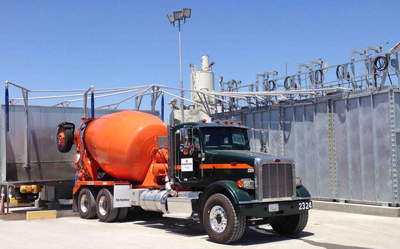| Improving market conditions, land-locked sister properties, plus safety and environmental factors have spurred an upgrade of Graniterock’s Redwood City Building Materials property, one of the company’s two integrated ready mixed, asphalt and recycling plants serving Silicon Valley. The Redwood City site sources aggregate by rail from the Graniterock Aromas quarry, about 75 miles south. |
Continuous improvement of processes and people is long-standing in the ready mixed concrete, aggregate, recycling and road-building businesses of Watsonville, Calif.-based Graniterock. The practice also applies to property, as demonstrated at the Redwood City Building Materials site, where the producer is revisiting a) returned concrete and truck washout handling methods sidelined since the late 1990s and, b) space utilization on a limited footprint.
Graniterock is among ready mixed producers that installed reclaimers for aggregate and slurry recycling, but abandoned them due to equipment limitations and cost-benefit factors. Improved reclaiming and water management equipment, coupled with the scarcity of land from San Francisco to Silicon Valley, have compelled the producer’s Concrete Division to manage its own process-waste stream.
“As a vertically integrated operator, we have aggregate and slurry disposal options,” says Concrete Division Manager Mike McGrath. “We feel we need to sustain materials internally. Sister recycling facilities are available to help, but don’t like to deal with a ready mixed plant’s waste. They are land-locked and want to maximize yard space available for outside customers.” Northern California’s technology industry-fueled construction market has enabled Graniterock to invest in plant and fleet equipment, he adds, marking “a big change from four to six years ago.”
SETTLING POND SUNSET
The 15-acre Redwood City Building Materials operation is midpoint between San Francisco and Graniterock’s San Jose Concrete plant. The sites reach much of Silicon Valley, one of the country’s hottest building markets thanks to major jobs under way for Apple, Facebook, Google and peers.
Approaching peak construction season, Tracy, Calif.-based DHE Inc. delivered the Redwood City plant a 45-yd./hour capacity Bibko 4000 concrete reclaimer, fed by a six-truck, 6.5-yd. buffer vessel, plus a 21,000-gal. Noble slurry tank equipped with four agitators running on 3-hp motors. With the exception of a few painted reclaimer components and motor housing parts, all surfaces are galvanized and all equipment above-grade.
“This is a huge improvement compared to systems of the past,” says McGrath. “When we looked at safety and maintenance, the above-grade approach was much preferred to a slurry pit.” California will eventually require monitoring of below grade pit seepage, including basic settling ponds, he adds, and Graniterock does not want to be behind the curve once regulations take hold.
 |
| The Bibko 4000 can separate coarse and fine aggregate from up to 45 yd. of returned concrete and truck washout per hour. It operates without ramps or maintenance-prone butterfly valves; conveys slurry water for truck washout or two batch plants’ water weigh batchers for recycling in select orders; and, can collect yard water for use in the reclaiming loop. The basic model ships with galvanized steel body; dual wash chamber plus proprietary discharge conveyor; slurry water handling package; slurry agitator system; plus, electronic controls, wiring and plumbing components. |
More immediately, the Bibko 4000 eliminates waste hauling from concrete production to recycling areas and conserves what McGrath notes is a scarce commodity in many parts of California. “We want to minimize water usage and are training drivers to be as efficient as possible cleaning their trucks,” he affirms. “It’s a continual learning process, but for now we have the reclaimer station set so when drivers have less than 2.5 yards of returned material, they push a button for a 250-gallon washout. We allow a second 250-gallon charge for trucks returning with larger loads.”
Truck washout lines draw from the Nolan tank or the third of three sections forming a 10,000-gal. settling pond. Prior to the reclaimer installation, settled material, along with hardened, returned concrete placed in rows, was hauled to the plant’s recycling area. The pond will remain in the short term for stormwater capture; the structure could give way to more productive yard use down the road.
The reclaimer station is built on former powdered pigment storage space, between central mixed and transit mixed plants. Redwood City team members transfer reclaimed coarse and fine aggregate to dedicated stockpiles. On a typical production day, the Bibko equipment will capture 10–27 yd. of material, maintaining water and slurry volumes in agitation. DHE equipped the rectangular Nolan tank for real-time specific gravity, temperature and water level measurement. A variety of private and public work under current market conditions has enabled Graniterock to pick and choose days for gray water and reclaimed aggregate recycling.
Measured in recycling efficiency, reduced material transfer outside the Concrete Division and lower equipment maintenance requirements when compared to prior attempts at capturing recyclable aggregate and slurry water, success with the new reclaimer has Graniterock on track to install a similar unit at San Jose Concrete.
